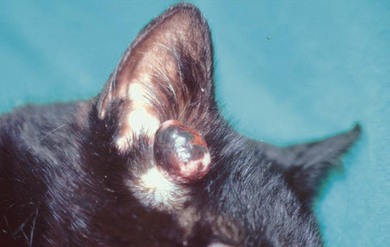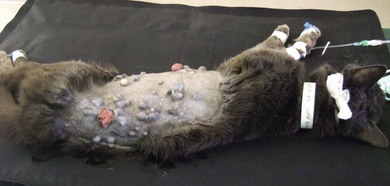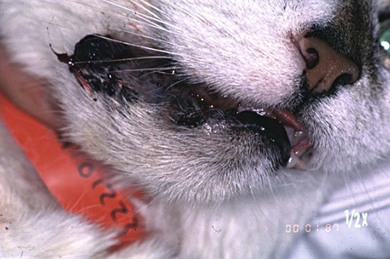Chapter 20 The skin is the largest and most easily observed organ in the body and therefore it is not surprising that the skin is a common site for tumor diagnosis in the cat. According to one large study, skin tumors comprised 9.6% of feline necropsy or biopsy specimens.1 Due to its complex structure, a large variety of tumors may arise in the skin and it is also a possible site for the development of secondary, metastatic tumors. This chapter will consider tumors arising from or within the epidermis, dermis and related structures and soft tissue tumors, which may arise within dermal connective tissue; the reported incidence of these tumors in the cat is summarized in Table 20-1.2 Table 20-1 The reported incidence of skin tumors in the cat Reprinted from Goldschmidt MH and Shofer FS, Skin Tumours of the Dog and Cat. 2008. Copyright ©John Wiley and Sons, with permission. The skin is a complex organ essentially comprising two layers: In addition, there are associated sebaceous and sweat glands and hair follicles, collectively termed the ‘adnexae’, plus melanocytes, histiocytes, and dermal mast cells. Any of these tissues and cells may give rise to benign or malignant tumors. Squamous cell carcinoma is the most frequent malignant tumor of the skin in the cat. Benign skin tumors, e.g., lipoma and adenoma, are less common in the cat as compared with the dog, with the exception of basal cell tumors. A presumptive diagnosis of a solitary skin tumor may be made on the clinical examination, including visual inspection and palpation. Skin tumors that present as multifocal lesions may be harder to distinguish from other dermatological conditions. In both cases skin tumors must be differentiated from other skin lesions (Box 20-1). Skin punch, needle, or incisional biopsies are required for a definitive histological diagnosis. Collection of a representative sample of tissue is important. Areas of ulceration and necrosis should be avoided and it is important to collect a deep enough sample of the tumor. Careful planning of the biopsy procedure should be made so that seeding of tumor cells through normal tissue planes is avoided. Definitive surgery should include the biopsy tracts, as they are regarded as contaminated. Excisional biopsy (i.e., local resection of the whole mass) is not generally recommended, except as a diagnostic procedure in a case with multiple skin lesions. More details on biopsy techniques can be found in Chapter 14. Clinical staging of primary tumors of the skin is by clinical examination and imaging of body cavities where indicated by the nature of the primary tumor. The primary tumor is assessed on the basis of its size, infiltration of the subcutis, and involvement of other structures such as fascia, muscle, and bone (Box 20-2). For more information on tumor staging see Chapter 14. This tumor is relatively common in the cat and usually affects middle-aged to older animals. It is reported to account for 14– 26% of feline skin tumors1,2 or for 34% of feline epithelial tumors.3 Tumors are usually solitary, discrete, firm, well-circumscribed masses, sited in the dermis and subcutis of the head and neck (Fig. 20-1). The overlying skin may be ulcerated. Most tumors are small, 0.5–2.0 cm in diameter, although on occasion they may reach up to 10 cm in size. Some feline basal cell tumors contain abundant melanin pigment and may therefore be confused on gross inspection with melanoma. Various subtypes have been described based on the histological appearance, e.g., solid, cystic, adenoid, and medusoid. Diagnosis can be made on cytological examination; however, the occurrence of cells with characteristic basal cell-like appearance has been shown to be an inconsistent finding in cats.4 These are usually slow-growing, non-invasive tumors that follow a benign course and rarely metastasize. Occasionally, more invasive tumors may be seen that are similar to the human ‘rodent ulcer’. Local/wide local surgical excision is the treatment of choice and in most cases is curative so the prognosis is good. Local recurrence can occur following incomplete surgical excision. Results from one study indicated that quantitative analysis of the nuclei of basal cell carcinoma neoplastic cells (by nuclear morphometry) is able to predict recurrent tumor growth and helps to differentiate histological subtypes in cats, which may be of practical value.5 • Tumors of hair follicles (trichoelipthelioma and pilomatricoma) • Glandular tumors (sebaceous, apocrine, meibomian, ceruminous). In one survey of feline follicular tumors in Italy trichoblastoma was reported as the most common form, representing 26% of cases. Follicular tumors and tumor-like lesions together represented 8% of all skin tumors in the cat.6 All these tumors are slow growing, non-invasive and benign in their behavior. Malignant tumors arising from the adnexal structures of the skin are extremely rare in the cat. Feline cutaneous SCC most frequently occurs on the head, affecting particularly the pinnae, nasal planum, and eyelids (Figs 20-2 to 20-4). The etiology in the majority of cases is related to long-term exposure of unprotected skin (non-pigmented, hairless regions) to ultraviolet light, with lesions initially of solar dermatitis progressing to actinic keratitis (actinic carcinoma in situ) to carcinoma in situ to invasive SCC, often over quite a long course of time. Ultraviolet-related p53 lesions have been identified in feline SCC. Clinically these lesions are crusty, scabby, ulcerated to plaque-like. Diagnosis is made by tissue biopsy and histology. Staging beyond local disease is not usually necessary. Figure 20-2 Squamous cell carcinoma (A) on the pinna of a white cat, (B) on the nasal planum, and (C) on the eyelid. These sunlight-induced lesions are generally slowly progressive, locally invasive and very rarely metastasize. Wide local surgical excision is the treatment of choice, and in cases where this can be achieved, the prognosis is favorable. Early diagnosis and prompt and effective treatment are recommended for these lesions as, if left, over time they can become more invasive and less responsive to treatment. Surgery is the only effective means of management of more extensive lesions (see Chapters 50 and 54). For early lesions, local control may be also achieved by a number of other methods including cryosurgery and strontium radiotherapy. Superficial lesions may also be treated successfully with photodynamic therapy (PDT) that offers the advantage of excellent cosmetic results. One of the authors (JMD) has experience of using a topical method of applying the photochemical, 5-aminolevulinic acid (ALA) and excitation using a high intensity red light. An 85% complete response rate was seen in 55 cats with superficial Tis–T1 tumors, treated with topical PDT, and at a median follow up of 1146 days 45% of cats were alive and disease free.7 There are also reports in the literature of use of an immunomodulatory agent imiquimod (Aldara) as a topical cream in cats with superficial or multicentric SCC.8 Electrochemotherapy, involving the administration of a chemotherapeutic agent alongside the delivery of appropriate waveforms that induce and increase uptake of the drug by cancer cells, has also been described as a successful treatment in cats, with some cats responding for up to three years.9 However, a larger scale trial is required before this therapy can be recommended. One study evaluating the prognosis of feline cutaneous SCC looked at the role of epidermal growth factor receptors (EGFR). Results indicated that 74% of tumors were positive for EGFR and this did not correlate with tumor differentiation or mitotic activity. However, patients with EGFR-positive tumors had a significantly worse outcome with decreased disease free intervals (DFIs) and survival times. It was postulated that using EGFR inhibitors in addition to conventional treatments may therefore improve outcomes for some cats with SCC.10
Skin tumors
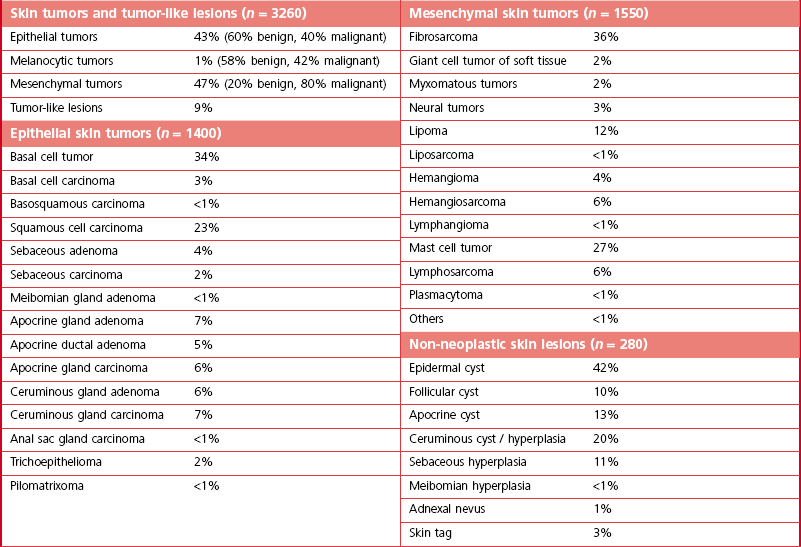
Pathogenesis
Pathology
General clinical approach
Clinical examination
Biopsy and fine needle aspiration
Staging
Epithelial tumors
Basal cell tumor/carcinoma
Treatment and prognosis
Tumors of the adnexae
Squamous cell carcinoma
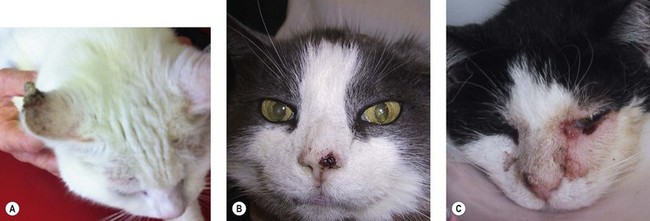
Treatment and prognosis
![]()
Stay updated, free articles. Join our Telegram channel

Full access? Get Clinical Tree


Skin tumors

